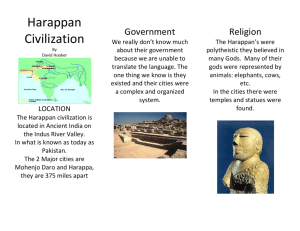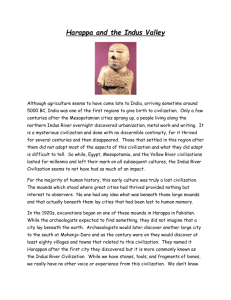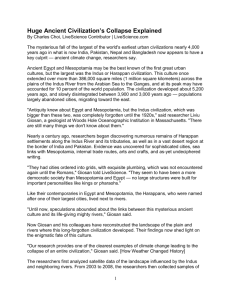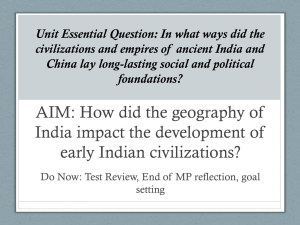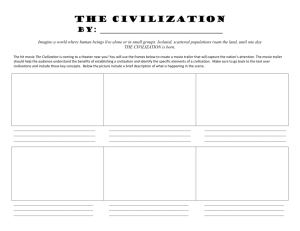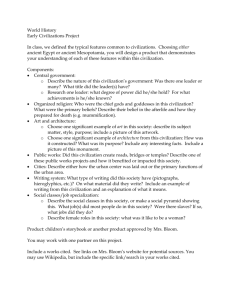The Decline of India`s Oldest Civilization Civilizations don`t suddenly
advertisement
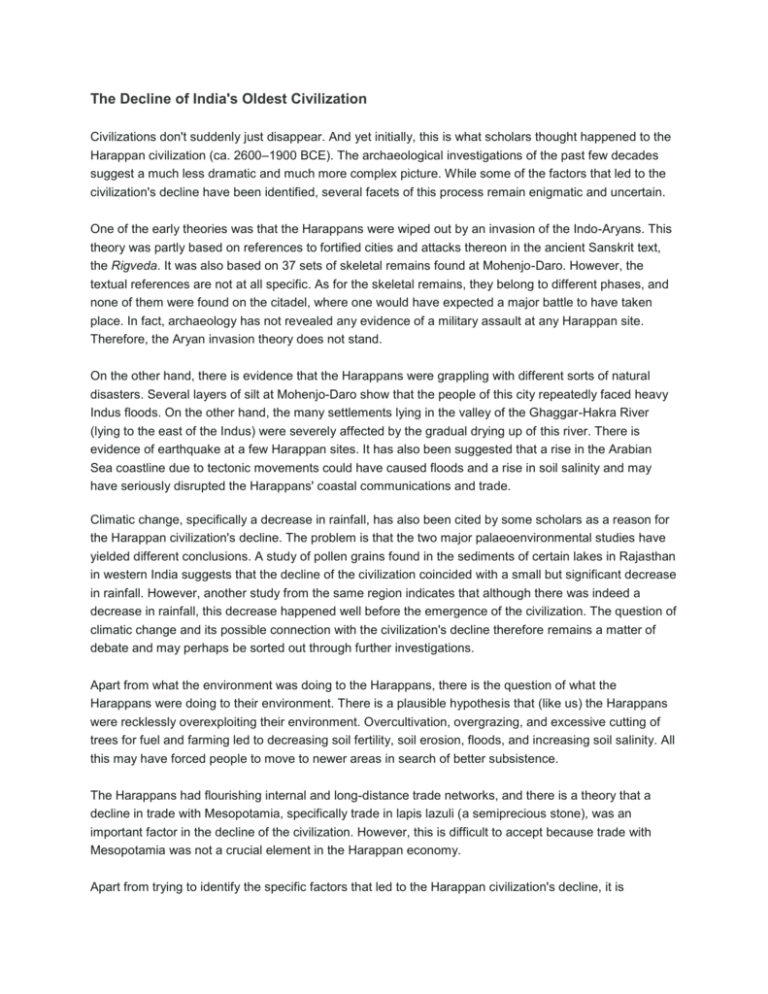
The Decline of India's Oldest Civilization Civilizations don't suddenly just disappear. And yet initially, this is what scholars thought happened to the Harappan civilization (ca. 2600–1900 BCE). The archaeological investigations of the past few decades suggest a much less dramatic and much more complex picture. While some of the factors that led to the civilization's decline have been identified, several facets of this process remain enigmatic and uncertain. One of the early theories was that the Harappans were wiped out by an invasion of the Indo-Aryans. This theory was partly based on references to fortified cities and attacks thereon in the ancient Sanskrit text, the Rigveda. It was also based on 37 sets of skeletal remains found at Mohenjo-Daro. However, the textual references are not at all specific. As for the skeletal remains, they belong to different phases, and none of them were found on the citadel, where one would have expected a major battle to have taken place. In fact, archaeology has not revealed any evidence of a military assault at any Harappan site. Therefore, the Aryan invasion theory does not stand. On the other hand, there is evidence that the Harappans were grappling with different sorts of natural disasters. Several layers of silt at Mohenjo-Daro show that the people of this city repeatedly faced heavy Indus floods. On the other hand, the many settlements lying in the valley of the Ghaggar-Hakra River (lying to the east of the Indus) were severely affected by the gradual drying up of this river. There is evidence of earthquake at a few Harappan sites. It has also been suggested that a rise in the Arabian Sea coastline due to tectonic movements could have caused floods and a rise in soil salinity and may have seriously disrupted the Harappans' coastal communications and trade. Climatic change, specifically a decrease in rainfall, has also been cited by some scholars as a reason for the Harappan civilization's decline. The problem is that the two major palaeoenvironmental studies have yielded different conclusions. A study of pollen grains found in the sediments of certain lakes in Rajasthan in western India suggests that the decline of the civilization coincided with a small but significant decrease in rainfall. However, another study from the same region indicates that although there was indeed a decrease in rainfall, this decrease happened well before the emergence of the civilization. The question of climatic change and its possible connection with the civilization's decline therefore remains a matter of debate and may perhaps be sorted out through further investigations. Apart from what the environment was doing to the Harappans, there is the question of what the Harappans were doing to their environment. There is a plausible hypothesis that (like us) the Harappans were recklessly overexploiting their environment. Overcultivation, overgrazing, and excessive cutting of trees for fuel and farming led to decreasing soil fertility, soil erosion, floods, and increasing soil salinity. All this may have forced people to move to newer areas in search of better subsistence. The Harappans had flourishing internal and long-distance trade networks, and there is a theory that a decline in trade with Mesopotamia, specifically trade in lapis lazuli (a semiprecious stone), was an important factor in the decline of the civilization. However, this is difficult to accept because trade with Mesopotamia was not a crucial element in the Harappan economy. Apart from trying to identify the specific factors that led to the Harappan civilization's decline, it is important to understand that the civilization was part of a very long cultural process. It did not emerge suddenly, nor did it suddenly disappear into thin air. What we call the "Harappan civilization" represents the developed, urban phase of the culture, which archaeologists also call the "mature Harappan" phase. The mature Harappan culture, i.e. the city-based civilization, was followed by a post-urban phase, referred to by archaeologists as the "late Harappan" culture. The transition from the mature to the late Harappan phase shows some elements of continuity, but much change. The cities, script, seals, specialized crafts, and long-distance trade declined but did not completely disappear. Writing survived in the form of graffiti on pottery. Some late Harappan sites show flourishing specialized craft activity. Many sites give evidence of an expansion and diversification of agriculture. All this can be connected to the larger patterns of settlement history. In parts of the northwest, there is clear evidence that some settlements were declining, others abandoned. But as we move toward the eastern and southern parts of the Harappan culture zone (see the map), we actually see an increase in the number of settlements. The data shows that the Harappans were migrating eastward and southwards. The general picture we get is one of a breakdown of urban structures and networks and an expansion of rural ones. Some of the environmental reasons for the urban collapse have been mentioned above. The fact that several such factors were involved—for instance floods in one area, drought in another—is not surprising, given the enormous area (some 680,000 to 800,000 square kilometers) covered by the civilization. At the same time, we must note that archaeological evidence does not directly tell us about the social and political aspects of the civilizational crisis, and crucial answers to the question of what happened to the Harappans may in fact lie in these spheres. Nevertheless, what the evidence does indicate is that the Harappans did not vanish. Some of them continued to live in the declining cities and towns, while others moved eastwards into the Gangetic valley and southwards into Gujarat, in search of more abundant resources and better livelihoods. The Decline of India’s Oldest Civilization Directions: After reading the article, you will write a 2 paragraph essay on what you think happened to the Harappan civilization. Refer to the outline below to help you organize your thoughts. Paragraph 1: What do you think happened to the Harappan civilization? Why do you think that way? Reason #1 – What evidence/information do you have to support your answer? (3 sentences) Be specific! Paragraph 2: Reason #2 – What other evidence/information do you have to support your answer? (3 sentences) Be specific! Sum up or restate what you think happened to the Harappan civilization. Closing statement as to why you think that way.

